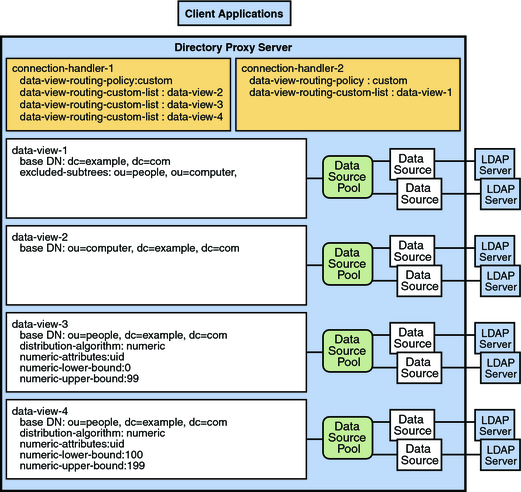| Skip Navigation Links | |
| Exit Print View | |

|
Oracle Directory Server Enterprise Edition Reference 11 g Release 1 (11.1.1.5.0) |
| Skip Navigation Links | |
| Exit Print View | |

|
Oracle Directory Server Enterprise Edition Reference 11 g Release 1 (11.1.1.5.0) |
1. Directory Server Enterprise Edition File Reference
Software Layout for Directory Server Enterprise Edition
Directory Server Instance Default Layout
Directory Proxy Server Instance Default Layout
Part I Directory Server Reference
4. Directory Server LDIF and Search Filters
6. Directory Server Monitoring
7. Directory Server Replication
8. Directory Server Data Caching
11. Directory Server Groups and Roles
12. Directory Server Class of Service
14. Directory Server Internationalization Support
Part II Directory Proxy Server Reference
15. Directory Proxy Server Overview
16. Directory Proxy Server Load Balancing and Client Affinity
17. Directory Proxy Server Distribution
18. Directory Proxy Server Virtualization
19. Connections Between Directory Proxy Server and Backend LDAP Servers
20. Connections Between Clients and Directory Proxy Server
Criteria for Allocating a Connection to a Connection Handler
Resource Limits Policies for Connection Handlers
Request Filtering Policies for Connection Handlers
Subtrees in the Request Filtering Policy
Search Data Hiding Rules in the Request Filtering Policy
21. Directory Proxy Server Client Authentication
22. Security in Directory Proxy Server
23. Directory Proxy Server Logging
When a connection is allocated to a connection handler, requests on the connection are exposed to a list of data views configured for that connection handler. The list of data views for a connection handler can contain zero, one, or multiple data views.
If the list of data views is empty, requests on the connection are not distributed to any data view. Applications using the connection cannot access any data and a No such Object error is returned.
If the list of data views contains multiple data views, requests on the connection are distributed to the data view that most specifically corresponds to the target DN of the request. For example, in Figure 20-1, requests on a connection in connection-handler-1 can be distributed to data-view-2, data-view-3 or data-view-4. However, if a search request has a target DN of ou=people,dc=example,dc=com, the request is distributed either to data-view-3 or to data-view-4.
Figure 20-1 List of Data Views in a Connection Handler

Affinity can be defined between a client connection and the data view selected to respond to requests on that connection. This feature is called data view affinity. When data view affinity is enabled, successive requests on a client connection are exposed exclusively to the data view used for the first request on that connection.
When data view affinity is enabled it takes precedence over other types of routing. For example, in Figure 20-1, a search request with a target DN of ou=computer,dc=example,dc=com is exposed to data-view-2. All subsequent requests on that client connection are exposed exclusively to data-view-2. If a subsequent request on that client connection has a target DN of ou=people,dc=example,dc=com, the request is exposed to the data view for ou=computer,dc=example,dc=com, not the data view for ou=people,dc=example,dc=com.
For information about how to configure data view affinity, see To Configure Affinity for Data Views in Oracle Directory Server Enterprise Edition Administration Guide.